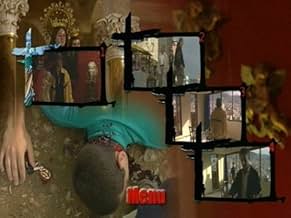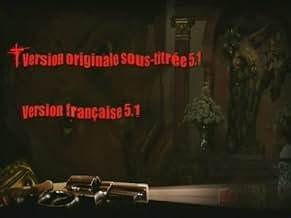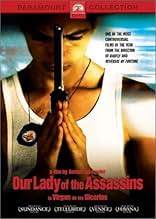IMDb RATING
6.8/10
4.4K
YOUR RATING
The writer F. Vallejo returns to Medellin after an absence of over 30 years. He meets 16-year-old Alexis. Alexis is the kind of killer who knocks people off on command. The two are immediate... Read allThe writer F. Vallejo returns to Medellin after an absence of over 30 years. He meets 16-year-old Alexis. Alexis is the kind of killer who knocks people off on command. The two are immediately attracted to each other.The writer F. Vallejo returns to Medellin after an absence of over 30 years. He meets 16-year-old Alexis. Alexis is the kind of killer who knocks people off on command. The two are immediately attracted to each other.
- Awards
- 3 wins & 3 nominations total
Featured reviews
10jetwimp
A middle-aged Colombian writer, disgusted with life and contemptuous of religion, becomes involved sexually and romantically with teen-aged Medellin boys who kill effortlessly and with little provocation. At first appalled, he eventually grows addicted to the deaths the boys bring about, their magical ability to resolve the annoyances of everyday life, such as noisy neighbors and aggressive cab subway riders. The plot has some really astonishing surprises, and the taut nearly flawless script (in Spanish) is a treasure. The film , obviously the product of a philosophically inclined mind (Schroeder studied philosophy at the Sorbonne), is a thinking filmgoer's feast and works on many different levels. The main character's ambivalence about religion (the film's title, and the fact that the writer keeps finding himself in cathedrals) furnishes much matter for reflection. This film is not for everyone--- it is, even for these times, shocking. Those more comfortable with the blowsy and predictable product issuing from Hollywood committees should probably avoid it. But those who treasure the ability of film to explore provocative and original ideas will love it.
Hi, I was reading about the comments of the movie "La virgen de los sicarios"... some people think that there is bad acting in this movie, and i am disagree absolutely... I live in Cali, Colombia and i can assure you that what you see in the film is exactly what you can see in the real live in some poor parts of the colombian cities... i am talking about everything: the way people talk, the way they move, all is very real... if you live in this country, you can understand that the actors in the movie are not acting... they are living!!! because that what you see in the movie is what we are in Colombia. Thanks for your attention.
Occasionally venturing into dreamlike surrealism, the movie mostly hits you with a heavy dose of cinema verite. The movie is about the city of Medellin in the same way that Midnight Cowboy is about New York. The characters aren't dealing with the problem of staying human in a huge metropolis, but staying human in the midst of instability that verges on anarchy.
The effects of fifty years of civil war aggravated by narcotrafficking and the associated crime are shown in two ways, which are the central themes of the film: the shift from the old and traditional to the modern, and the loss of value that human life has suffered. The banality of the several killings in the movie drives home the second, and the explorations that Fernando and his two boyfriends (sequential, not simultaneous) take through the city show the first.
The movie is violent like the Godfather is violent: the killings are not gratuitous, they are there to make a point. As a document of life in an industrial Andean city which just happens to be the second city of the country poised to become the next Vietnam, or better said, the next El Salvador, La virgen de los sicarios is excellent. It is sophisticated in its writing and its photography. The characters are human and complex. It ought to be in far wider release than just one screen in the whole L.A. area - which happens to be on the West Side, where Spanish-speaking people typically don't live.
The effects of fifty years of civil war aggravated by narcotrafficking and the associated crime are shown in two ways, which are the central themes of the film: the shift from the old and traditional to the modern, and the loss of value that human life has suffered. The banality of the several killings in the movie drives home the second, and the explorations that Fernando and his two boyfriends (sequential, not simultaneous) take through the city show the first.
The movie is violent like the Godfather is violent: the killings are not gratuitous, they are there to make a point. As a document of life in an industrial Andean city which just happens to be the second city of the country poised to become the next Vietnam, or better said, the next El Salvador, La virgen de los sicarios is excellent. It is sophisticated in its writing and its photography. The characters are human and complex. It ought to be in far wider release than just one screen in the whole L.A. area - which happens to be on the West Side, where Spanish-speaking people typically don't live.
Medellin is a dangerous city in more ways than one is lead to believe. At the time of the action, Pablo Escobar's empire has been dismantled and his loyal soldiers are scattered all around the city engaging in a game of death, revenge and petty vendettas. There is no reverence for life in a place that has seen violence on a daily basis and where children have access to guns for protection in order to survive in that environment.
Barbet Schroeder, the German director, expands on Fernando Vallejo's novel, which the author adapted for the screen, resulting in a highly violent and bloody film that is disturbing, as well as true.
Fernando, the older gay man who comes back to his native city of Medellin, quickly finds a boy to satisfy his needs. Alexis, the young man, is seen at first at the all-male brothel where he is offered by the pimp to Fernando. Alexis turns out to be something the older man didn't expect. This is a boy that is savvy in the ways of how to survive in the city, who clearly takes an interest in the older, and richer Fernando.
Alexis is a marked man and it's only a matter of time; his days are numbered because there are other youths behind him that will do whatever in their power to eliminate him. Fernando can't believe what his city has become, but he has no desire to go away again. When Alexis is killed, Fernando mourns his death until Wilmar, another young gay man appears in his orbit. Little prepares Fernando to realize who Wilmar is really.
Fernando's comments on the situation in his city, as well as in the Colombian reality, are the basic themes of the film. While one side of him cries for that old place he knew as a child, he welcomes this new metropolis full of danger and people that attracts and repulses him at the same time.
German Jaramillo appears to be the alter ego for the writer, Fernando Vallejo, whose story seems to resemble that of the Fernando in the novel and in the film. Mr. Jaramillo's take on Fernando keeps him away from the confrontations between his young lovers and what he thinks is right. He never passes judgment on what the young people are doing, yet he is instrumental for providing the bullets that Alexis needs to defend himself. The other two young actors, Anderson Ballesteros and Juan Diego Restrepo, play Alexis and Wilmar respectively.
Barbet Schroeder has directed the film with all its realism showing us a society in which all hope seems to have abandoned the citizens of the city.
Barbet Schroeder, the German director, expands on Fernando Vallejo's novel, which the author adapted for the screen, resulting in a highly violent and bloody film that is disturbing, as well as true.
Fernando, the older gay man who comes back to his native city of Medellin, quickly finds a boy to satisfy his needs. Alexis, the young man, is seen at first at the all-male brothel where he is offered by the pimp to Fernando. Alexis turns out to be something the older man didn't expect. This is a boy that is savvy in the ways of how to survive in the city, who clearly takes an interest in the older, and richer Fernando.
Alexis is a marked man and it's only a matter of time; his days are numbered because there are other youths behind him that will do whatever in their power to eliminate him. Fernando can't believe what his city has become, but he has no desire to go away again. When Alexis is killed, Fernando mourns his death until Wilmar, another young gay man appears in his orbit. Little prepares Fernando to realize who Wilmar is really.
Fernando's comments on the situation in his city, as well as in the Colombian reality, are the basic themes of the film. While one side of him cries for that old place he knew as a child, he welcomes this new metropolis full of danger and people that attracts and repulses him at the same time.
German Jaramillo appears to be the alter ego for the writer, Fernando Vallejo, whose story seems to resemble that of the Fernando in the novel and in the film. Mr. Jaramillo's take on Fernando keeps him away from the confrontations between his young lovers and what he thinks is right. He never passes judgment on what the young people are doing, yet he is instrumental for providing the bullets that Alexis needs to defend himself. The other two young actors, Anderson Ballesteros and Juan Diego Restrepo, play Alexis and Wilmar respectively.
Barbet Schroeder has directed the film with all its realism showing us a society in which all hope seems to have abandoned the citizens of the city.
Barbet Schroeder's Our Lady of the Assassins is a perplexing film. Yet, it is ultimately rewarding in ways that most films aren't.
Shot in high definition digital video, the film has an immediacy to it that cannot be simulated by film. At first, the immediacy seems to cheapen the look and one wonders what Schroeder was thinking when he decided to undertake this format. Yet as the complexity of the story progresses, we seem to be "taken in" by the video's hypnotic effect and we realize that we are viewing a medium with its own look, feel and characteristics and we accept it.
About an older man who befriends and enters into a relationship with a young ex-gang member, the story takes a while to unfold. In the beginning it seems all but pointless, yet within the hour, we are caught up in a film of overwhelming depth and emotional power. Schroeder deserves tremendous credit for having the courage to make a movie in which the main character openly denounces the church and where themes of political corruption and anarchy in a real world setting actually exist.
Most disturbing is that the themes in this movie ring true with an authenticity that cannot be challenged. We are simultaneously horrified yet held captive by a reality which we don't want to believe exists but that we know already does, not only in Colombia, where the film is set, but elsewhere as well. Schroeder is a master here of making the "city" of Medellin just as much a character as the protagonists. He charges the environment with an electricity that seems to pervade the screen and crawl into our psyches.
Unfortunately it is the medium itself which may prevent Our Lady of the Assassins from becoming a commercial success or as being taken seriously by a lot of people. But film purists and those who enjoyed the gritty realism of similar films like Pixote and Santa Sangre, should love this one.
Shot in high definition digital video, the film has an immediacy to it that cannot be simulated by film. At first, the immediacy seems to cheapen the look and one wonders what Schroeder was thinking when he decided to undertake this format. Yet as the complexity of the story progresses, we seem to be "taken in" by the video's hypnotic effect and we realize that we are viewing a medium with its own look, feel and characteristics and we accept it.
About an older man who befriends and enters into a relationship with a young ex-gang member, the story takes a while to unfold. In the beginning it seems all but pointless, yet within the hour, we are caught up in a film of overwhelming depth and emotional power. Schroeder deserves tremendous credit for having the courage to make a movie in which the main character openly denounces the church and where themes of political corruption and anarchy in a real world setting actually exist.
Most disturbing is that the themes in this movie ring true with an authenticity that cannot be challenged. We are simultaneously horrified yet held captive by a reality which we don't want to believe exists but that we know already does, not only in Colombia, where the film is set, but elsewhere as well. Schroeder is a master here of making the "city" of Medellin just as much a character as the protagonists. He charges the environment with an electricity that seems to pervade the screen and crawl into our psyches.
Unfortunately it is the medium itself which may prevent Our Lady of the Assassins from becoming a commercial success or as being taken seriously by a lot of people. But film purists and those who enjoyed the gritty realism of similar films like Pixote and Santa Sangre, should love this one.
Did you know
- TriviaGiven the fact that Anderson Ballesteros did a great job portraying a tough hitman with street knowledge, all the roles he got later were pretty much the same, for example, playing as Pablo Escobar's main hitman on "El Patrón del Mal"
- How long is Our Lady of the Assassins?Powered by Alexa
Details
- Release date
- Countries of origin
- Official site
- Languages
- Also known as
- Богоматір вбивць
- Filming locations
- Production companies
- See more company credits at IMDbPro
Box office
- Gross US & Canada
- $525,330
- Opening weekend US & Canada
- $56,069
- Sep 9, 2001
- Gross worldwide
- $624,525
- Runtime1 hour 41 minutes
- Color
- Sound mix
- Aspect ratio
- 1.78 : 1
Contribute to this page
Suggest an edit or add missing content

























